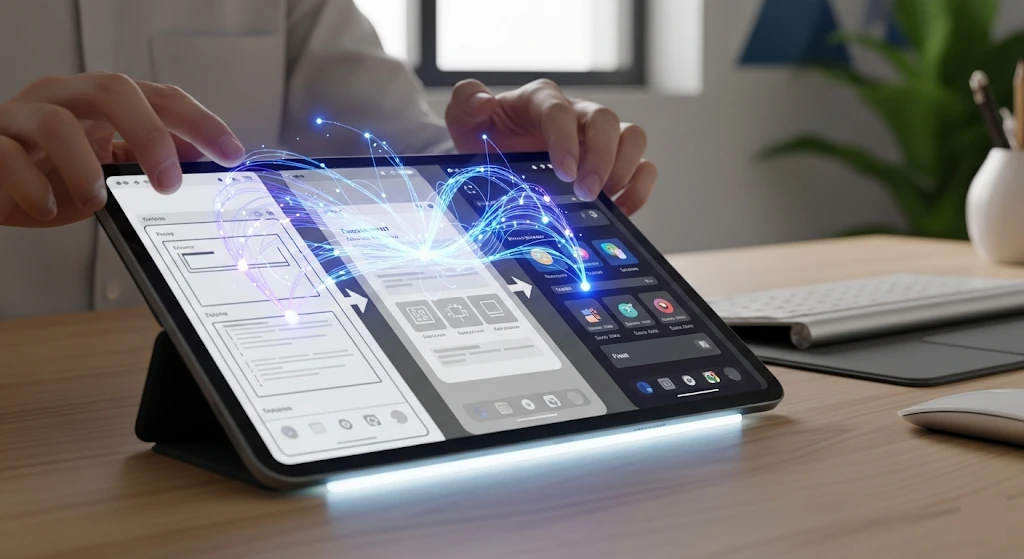Digital software prototyping is essentially building a working simulation of the actual application, before making the final product. This allows designers to effectively visualise, optimise and iterate their product digitally while saving costs associated with potentially wasted software development time.

In contrast to popular opinion, digital software prototyping is not just about creating a virtual model. It includes testing the model for its robust qualities by subjecting it to load conditions. Digital prototyping, therefore, helps with assessing the product’s behaviours and interactions within a system.
1. Get Started Right Away
Procrastination can affect businesses, especially in complex work environments where decision making is naturally stretched. Digital prototyping lowers risk, enables taking the first step, making the decision to start less dramatic, and quicker to take.
The capital and time required for digital software prototyping is not a lot. Choosing from a number of advanced prototyping tools, designers can start immediately, cross out suggestions and make changes quite easily to Incorporate new requirements and ideas. Continuous prototyping keeps up the workflow, and that too without incurring any extra expense or time.
2. Define and Refine The Idea Better
With digital software prototyping, designers can keep making changes to the prototype to improve the understanding of the product as it evolves. Digital prototyping gives the agility of continuously progressing the model to reach the intended product design, whilst allowing multiple changes and refinements throughout the process.
Using this methodology, designers can plan, optimise, validate, and visualise products beforehand, without needing to build any real model or the actual product. This allows them to identify and correct any faults that the product design may contain.
3. Save Money
For most developers, the cost will be a prime factor in prototyping and product design. Digital software prototyping helps to minimalise the actual production, which consequently reduces both the resources and labour required during the process. Since prototyping also makes the development cycle shorter, the cost is reduced.
Additionally, with digital software prototyping, one can have a single person working on it, or better, the entire team can be employed and concurrently craft different prototypes.
Previously, software engineers would first have to reach the end of the development phase before testing their designs. This incurred exaggerated and unnecessary costs, and if something went awry in the process, it meant the entire cycle would have to be repeated. Today, design engineers deploying digital software prototyping skills can create working, virtual models, which they can remake without incurring any significant additional expense.
4. Rapidly Test To Identify Faults and Get Feedback
Digital software prototyping can help identify issues and faults that may have otherwise gone unnoticed, and then lets the team correct the problem without losing money on the final product. Prototyping eliminates potential losses from mistakes made later in the development process. Rapidly developing new prototypes, identifying problems, correcting them and learning from them is a valuable feedback process which should not be underestimated.
Additionally, with digital software prototyping, it is much easier to test the usability and utility of a function before it is developed. For instance, prototypes can be used to show a client how an idea will look and feel when it has been developed and by working with multiple prototypes — all of which essentially perform the same function — the client can select the one which is the most appropriate to go forward into the final product.
The faster the final product is built, the sooner it is handed over to the customer, and the earlier the company can get feedback from its customers. Feedback is crucial for any business’ success, and faster customer service is likely to bring in stellar feedback.
5. Create Accurate Models Efficiently
A modern software prototype can be generated to an exceptionally fine precision. This allows businesses to accurately model how a real version of the software to be developed might function – without going through the hassle of actually making it.
In product development, one wants to route through the Build-Measure-Learn loop as many times as possible. A digital software prototype can be potentially altered an infinite number of times, and multiple versions of it can be stored, to be worked on later using various devices.
6. Collaborate and Communicate With xDesign
Digital software prototyping can also assist a designer to integrate the whole team’s ideas; from the client to the content team and designers, and anyone else who may have the skill to design and a say in the finished product. Digital prototyping condenses the development cycle and avoids numerous unnecessary consultations and meetings. Modifications can be made on the spot, reducing the tedious back and forth communication that can defer the final production.
In modern manufacturing, it is expected for the entire design team to be collaborating on a single prototype. The whole team being able to work on the same data simultaneously is, therefore, an invaluable requirement, which an excellent digital software prototyping package like xDesign will fulfil. xDesign integrates user-friendly software with an original approach to design and cloud collaboration from inside your browser. It allows users to understand workflow progress by making collaborative tasks, allotting them, and linking them to various parts of the project while monitoring the performance progress.
Rezaid uses xDesign to prototype apps and provide a superior quality of design.
Conclusion
Digital software prototyping brings numerous benefits. Although a relatively new technology, it is rapidly advancing. More and more businesses are opting for digital prototyping as a means of saving time and money whilst simultaneously delivering a better quality of design
Digital prototyping is changing the face of the design industry. From the days of going straight to developing the final software, to first making digital prototypes, the software industry surely has come a long way. Digital software prototyping offers user-friendly UI/UX designs, rapid user testing and remodelling. In short, prototyping has opened a gateway to intuitive UI/UX design.
